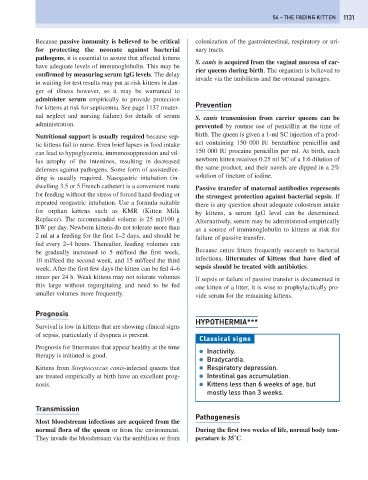Page 1139 - Problem-Based Feline Medicine
P. 1139
54 – THE FADING KITTEN 1131
Because passive immunity is believed to be critical colonization of the gastrointestinal, respiratory or uri-
for protecting the neonate against bacterial nary tracts.
pathogens, it is essential to assure that affected kittens
S. canis is acquired from the vaginal mucosa of car-
have adequate levels of immunoglobulin. This may be
rier queens during birth. The organism is believed to
confirmed by measuring serum IgG levels. The delay
invade via the umbilicus and the oronasal passages.
in waiting for test results may put at-risk kittens in dan-
ger of illness however, so it may be warranted to
administer serum empirically to provide protection
Prevention
for kittens at risk for septicemia. See page 1137 (mater-
nal neglect and nursing failure) for details of serum S. canis transmission from carrier queens can be
administration. prevented by routine use of penicillin at the time of
Nutritional support is usually required because sep- birth. The queen is given a 1-ml SC injection of a prod-
tic kittens fail to nurse. Even brief lapses in food intake uct containing 150 000 IU benzathine penicillin and
can lead to hypoglycemia, immunosuppression and vil- 150 000 IU procaine penicillin per ml. At birth, each
lus atrophy of the intestines, resulting in decreased newborn kitten receives 0.25 ml SC of a 1:6 dilution of
defenses against pathogens. Some form of assistedfee- the same product, and their navels are dipped in a 2%
ding is usually required. Nasogastric intubation (in- solution of tincture of iodine.
dwelling 3.5 or 5 French catheter) is a convenient route Passive transfer of maternal antibodies represents
for feeding without the stress of forced hand-feeding or the strongest protection against bacterial sepsis. If
repeated orogastric intubation. Use a formula suitable there is any question about adequate colostrum intake
for orphan kittens such as KMR (Kitten Milk by kittens, a serum IgG level can be determined.
Replacer). The recommended volume is 25 ml/100 g Alternatively, serum may be administered empirically
BW per day. Newborn kittens do not tolerate more than as a source of immunoglobulin to kittens at risk for
2 ml at a feeding for the first 1–2 days, and should be failure of passive transfer.
fed every 2–4 hours. Thereafter, feeding volumes can
be gradually increased to 5 ml/feed the first week, Because entire litters frequently succumb to bacterial
10 ml/feed the second week, and 15 ml/feed the third infections, littermates of kittens that have died of
week. After the first few days the kitten can be fed 4–6 sepsis should be treated with antibiotics.
times per 24 h. Weak kittens may not tolerate volumes If sepsis or failure of passive transfer is documented in
this large without regurgitating and need to be fed one kitten of a litter, it is wise to prophylactically pro-
smaller volumes more frequently. vide serum for the remaining kittens.
Prognosis
HYPOTHERMIA***
Survival is low in kittens that are showing clinical signs
of sepsis, particularly if dyspnea is present.
Classical signs
Prognosis for littermates that appear healthy at the time
● Inactivity.
therapy is initiated is good.
● Bradycardia.
Kittens from Streptococcus canis-infected queens that ● Respiratory depression.
are treated empirically at birth have an excellent prog- ● Intestinal gas accumulation.
nosis. ● Kittens less than 6 weeks of age, but
mostly less than 3 weeks.
Transmission
Pathogenesis
Most bloodstream infections are acquired from the
normal flora of the queen or from the environment. During the first two weeks of life, normal body tem-
They invade the bloodstream via the umbilicus or from perature is 35˚C.

